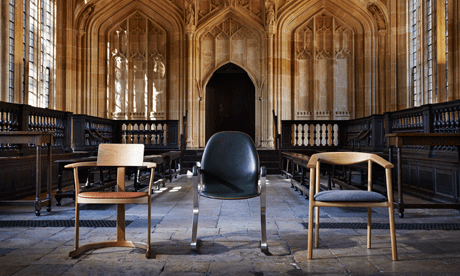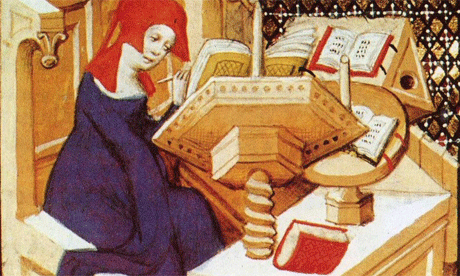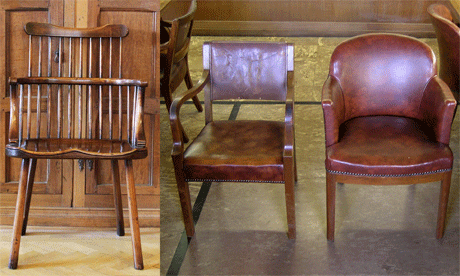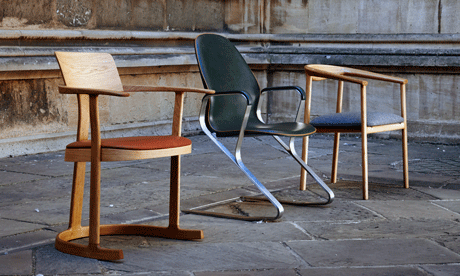by: Oliver Wainwright
 |
| Chairs on trial … the three shortlisted designs for the new Bodleain Library chair. Left to right: Barber Osgerby; Amanda Levete; Matthew Hilton. Photograph: Jamie Smith |
"Christine de Pizan seems to have had a thing for elaborate furniture," says Chris Fletcher, keeper of special collections at the Bodleian Library in Oxford. He is showing me a series of illuminations in the 400-year-old institution that depict the medieval author in a variety of situations: perched on a stool at a simple tilted desk, or sitting in a round-backed throne, she is surrounded by all manner of intriguing devices to aid the reading and writing of simultaneous texts.
But de Pizan, who is generally thought to be Europe's first professional female writer, is unusual for the period. "Libraries haven't always had the luxury of chairs," says Fletcher. "In medieval times, you would have had a book room, and then you would take the book out to the cloister to read. It's only in the post-medieval period that people started to read while sitting in the book rooms."
 |
| Thing for furniture … detail of Christine de Pizan in her study. Image: Flickr/Cea |
Records show that in 1756, three dozen Windsor chairs were bought from a Mr Munday, for the princely sum of 8s 6d each (about £120 in today's money) – beginning a story of scholarly sitting that reaches its latest chapter this week.
On show at the V&A from this Saturday, as part of the London Design Festival, are the three shortlisted designs for a new Bodleian chair for the 21st century. Whittled down from 60 designers, the finalists are an eclectic mix of Amanda Levete, former half of space-age architecture practice Future Systems, Barber Osgerby, designers of the Olympic torch, and Mathew Hilton, former head of furniture at Habitat.
They are competing for a prestigious commission that was last awarded to Giles Gilbert Scott in 1936, when he designed two seats to furnish his New Bodleian Library building, in the form of heavy leather-clad bucket chairs to match his stripped stone fortress of books. The building is currently undergoing a £78m renovation by Wilkinson Eyre architects – due to open next year – as a home for special collections. And special collections clearly need a very special chair.
"We wanted something that would be iconic and representative of the library," says the Bodleian's estates manager, Toby Kirtley. "It should be contemporary in style, but not out of place in a heritage setting – innovative and original, without being too experimental and risky."
The library currently makes do with a motley collection of seating, from municipal 1970s chairs to elegant wooden Oxford chairs from the 1860s, which have timber bracing forming an 'x' across an 'o' in the back. But there are few of the 18th-century Winsdor chairs left – although you can buy a replica in the Bod's shop for £750.
"Most academics probably don't even think about what they're sitting in," says Fletcher. "But, subconsciously, they have a very tactile and intuitive relationship with the spaces they work in."
"People are now used to reading all over the place on their iPhones, while waiting for the bus or on the train, so there is a renewed attraction to coming back to the sanctity of a specific, static space."
 |
| Windsor chair, left, 1756; Giles Gilbert Scott's chairs, right, 1936. Photograph: Bodleian Library |
"As digital information becomes more accessible, so the importance of the analogue also surfaces. It's like vinyl, or 35mm film: people are interested in objects and the innate quality of things."
Sitting in a room below the vaulted halls of the Bodleian's Duke Humfrey's library, we test out the three prototypes in front of a tilted manuscript, supported on the table by an adjustable foam book rest – the kind of thing de Pizan would no doubt have jumped at using.
First up is the most experimental of the bunch, a streamlined shell clad in dark green leather, designed by Amanda Levete and produced by Herman Miller. Held aloft on a steel frame, the seating shell sits on cantilevered legs that slope back in a dynamic sweep, with a look of Oscar Pistorius's running blades – suggesting readers might be launched towards the shelves at record-breaking speed. The leather follows the contours of the shell exactly, as if it has been sprayed on, the result of working with a manufacturer that usually fits out high-end concept cars.
It is a smooth, sleek thing, but it has a rather unfortunate bounce when you sit in it, as if an overenthusiastic recline might see you catapulted towards the precious manuscript with disastrous force. It also feels a little too slick for the hallowed halls of the Bod – looking more at home in a club-class departure lounge.
Next we have Matthew Hilton's offering, manufactured by long-time collaborator SCP. Like most of his work, it is a stripped-back classic design, executed with the utmost attention paid to the detail of every joint. It is a level of precision revealed by his accompanying notes, which apologise for the millimetre differences that the prototype show, in comparison to the planned final product.
It is a clean, simple form – described by Fletcher as "bravely traditional" – with a CNC-milled back that twists along its length as it extends out to form the arms, like a human bone. But the boniness is also felt when you sit in it: the geometric twist means that your arms lie on a pointed ridge when resting. The classic design also makes it look a little municipal, like a subtly souped-up version of the kind of thing you probably have in your local council library.
 |
| Final reckoning … the three contenders outside the Bodleian. Left to right: Barber Osgerby; Amanda Levete; Matthew Hilton. Photograph: Jamie Smith |
With a single straight spine that joins a continuous curving arm rest to a similarly-shaped rail on the floor, the form is also strongly reminiscent of Frank Lloyd Wright's Barrel Chair, designed in 1937 for the Wingspread house in Wisconsin. Seen in a row from behind, as they will be installed in the library, they appear to form a line of little rooms around the readers, defining a series of individual territories from the floor to the desk.
As Barber Osgerby have cleverly done before with their Tip Ton school chair, the bottom rail is also angled to allow the chair to be subtly tilted forward, or leaned back to recline.
"That could be an important feature for the users of special collections," says Fletcher. "You often want to get right in to see the variations in type, or annotations, or the chain lines in the paper."
Sitting down, it appears to be the most comfortable, with broad armrests set at the right height; although, as I tilt forward – engrossed in the detail of a ligature – it feels like there might be a chance of being deposited head-first into the folio.
The trio now faces a top panel of judges, including designer Sir Kenneth Grange and Martin Roth, director of the V&A, who has proclaimed that the winner will be declared "the chair of chairs, for the library of libraries".
As a classic form that would sit at home in the Gilbert Scott interiors, yet which has its own distinctive identity as an elegant and ergonomic design, my money's on Barber Osgerby.
from: Guardian
No comments:
Post a Comment